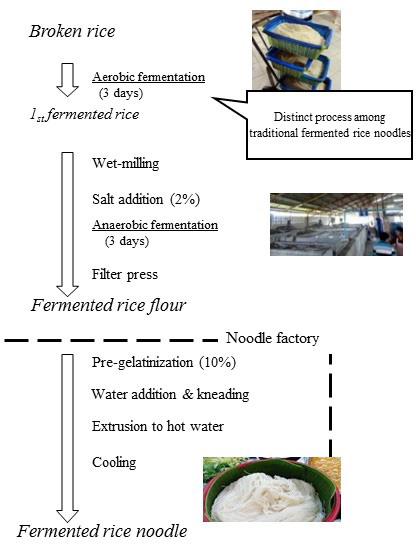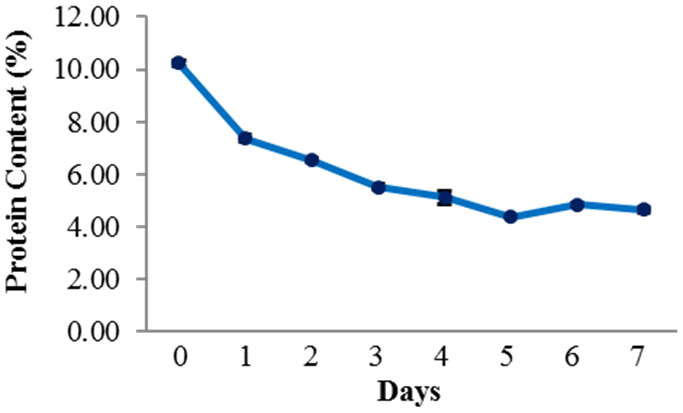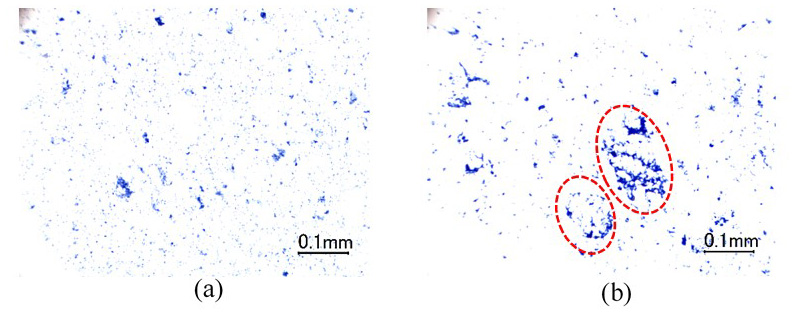Selective protein digestion during fermentation provides a distinctive texture to traditional fermented rice noodles in Indochina
Description
Traditional fermented rice noodles in Indochina are characterized by their unique flavor and pleasing texture. Locally known as Kanom-jeen (Thailand), Khao Pun (Laos), and Bun (Vietnam), they are widely consumed as a staple food throughout the region with the fermentation process considered a key step in providing its desirable attributes, especially texture.
Traditional preparation of Thai traditional fermented rice noodles, Kanom-jeen, involves the following steps: soaking of high amylose rice for 4-5 h in water, fermentation of the soaked rice grains for 3 days with aeration, wet-milling, fermentation of ground flour in saline solution for 3 days, filtration, kneading and pre-gelatinization, re-kneading to form a viscous slurry, extruding the viscous slurry into noodles, and cooking in boiling water (Fig. 1).
The results showed that protein content significantly decreased during the 1st aerobic fermentation process for 3 days as shown in Figure 2. Their protein composition revealed that Protein Body II, the digestible proteins in rice kernel, disappeared during rice fermentation, while Protein Body I, the indigestible proteins, remained. Microstructural analysis (Fig. 3) demonstrated that cluster-like structures consisting of digestible proteins were formed only in the non-fermented preparation, while fermented preparation contained only uniformly spherical protein bodies formed by the indigestible proteins in starch gel. The cluster-like protein structures are commonly found in gels of non-fermented noodles, resulting in a less uniform microstructure. These structural differences indicated that the traditional fermentation process can be considered a viable method for removing digestible proteins selectively from rice endosperm to provide a stronger gel. The fermentation process is, therefore, necessary during preparation to obtain the desired specific texture.
Eliminated proteins can be identified as part of rice allergenic proteins. Therefore, these findings may shed light on the effect of traditional processes on selective digestibility to determine its potential to reduce rice allergenicity. Moreover, remaining proteins that are indigestible have been considered as beneficial for chronic kidney disease patients who need to control their protein intake. These properties could provide benefits as a healthy food application based on traditional processing knowledge, consequently increasing the nutritional value of local traditional products.
Figure, table
-
Fig. 1. Traditional processing of Thai fermented rice noodles, Kanom-jeen.
-
Fig. 2. Changes in protein content of rice during fermentation.
Protein content significantly decreased during the 1st aerobic fermentation process for 3 days. -
Fig. 3. Protein localization in fermented (a) and non-fermented (b) rice noodles.
Cluster-like structures of digestible proteins were observed only in non-fermented noodles.
- Affiliation
-
Japan International Research Center for Agricultural Sciences Biological Resources and Post-harvest Division
- Research project
- Program name
- Term of research
-
FY2016(FY2016~FY2020)
- Responsible researcher
-
Tadashi Yoshihashi ( Biological Resources and Post-harvest Division )
Satmalee Prajongwate ( Institute of Food Research and Product Development, Kasetsart University, Thailand )
Vipa Surojanametakul ( Institute of Food Research and Product Development, Kasetsart University, Thailand )
Naraporn Phomkaivorn ( Institute of Food Research and Product Development, Kasetsart University, Thailand )
Panthavee Wanchai ( Kasetsart University )
- ほか
- Publication, etc.
-
https://doi.org/10.6090/jarq.51.309
Prajongwate S et al. (2017) Japan Agricultural Research Quarterly, 51(4), p. 309-318
- Japanese PDF
-
A4 365.21 KB
A3 257.66 KB
- English PDF
-
A4 543.57 KB
A3 532.36 KB
- Poster PDF
-
Poster 377.14 KB



